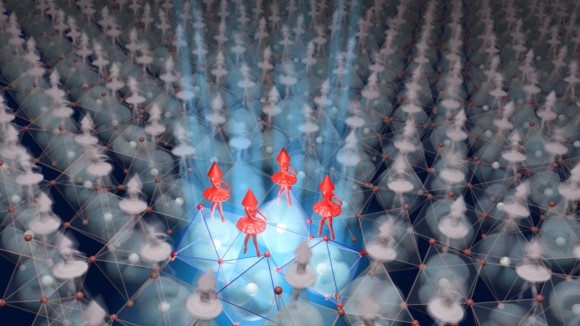Collection
Light Induced States of Matter
- Submission status
- Open
- Submission deadline
Progress in laser technology has recently enabled many advances in experimental probes and control tools of complex materials, with a focus on the nonlinear response of these solids. Nonlinear probes can be divided into two broad categories: perturbative and nonperturbative. Perturbative non-linear spectroscopies are based on the expansion of the response in powers of the drive, from which one extracts higher order response functions. These techniques for example are utilized in nonlinear optics to probe orders and symmetries invisible to linear optical probes. Nonperturbative responses have also become increasingly central to these studies, for example in experiments that aim to create transient states that are qualitatively different from the original equilibrium phases. In some cases, dynamical states exhibit properties that are not achievable in any equilibrium systems.
The present collection of articles will address the subject of the non-perturbative nonlinear response of materials, and the control of non-equilibrium many body phases of matter. This field is connected to earlier work in photo-induced phase transitions, and the spectacular developments in experimental methods resulted in dramatic progress in the last few years. This focused collection aims to provide a review of experimental techniques used to pump and probe materials, as well the many new theoretical insights developed in the field recently.
To set the stage we begin by briefly reviewing some of the ideas and research directions pursued in the field.
- Many studies of light induced states rely on the concept of “free energy landscape”. This approach assumes that relevant many-body states can be parametrized using a small number of slow degrees of freedom, such as competing order parameters. The equilibrium state corresponds to the global minimum of the free energy, however there may be additional local minima, corresponding to metastable states.
The pump pulse ejects the system from the global minimum and can result in it being trapped in a local minimum. Even in the absence of metastable states, different order parameters can relax with different rates. Then light induced dynamics through the “landscape” can result in the experimental signatures of subdominant order parameters, which are strongly enhanced compared to the initial equilibrium state. Optically induced melting of competing orders that suppress the formation of a specific phase at equilibrium are examples that have been explored extensively in many materials systems. - Several classes of models of nontrivial light induced states utilize the idea of Floquet driving. The latter refers to systems with parameters that are periodically modulated in time. Periodic modulation can come either from electric field of the pump pulse or from collective excitations launched by light (for example, phonons, the Higgs amplitude modes in CDW or superconducting states, Josephson plasmons). Floquet driving can modify the kinetic energy of the system, as well as changing topologically trivial band structures into topologically nontrivial ones. It can also modify interactions, and has thus been discussed as a technique for optically controlling Hamiltonians. Finally, periodic modulation can also result in the parametric coupling between different collective modes of a solid, leading to their amplification, suppression or their mutual synchronization.
- Creating nonequilibrium quasiparticle distributions, including metastable population trapping, is another route to reaching interesting transient states. One of the best-known examples is the Wyatt Dayem effect of superconductivity enhancement by microwave radiation. Eliashberg explained this phenomenon as arising from changes in the quasiparticle distribution by microwave radiation.
- Propagation of light in solid state systems is intimately connected to polariton modes, which correspond to coherent superpositions of photons and matter excitations. Polariton families include exciton-polaritons, photon-polaritons, Josephson plasmons, dipolar spin waves, just to name a few. Periodic modulation of material properties results in parametric driving of polariton modes, which can lead to dramatic changes in optical properties. Understanding pump induced changes in polaritons is an important aspect of unraveling properties of transient light induced states.
The current collection of articles will provide a review of these topics and many other research directions pursued in the context of light induced states of matter.

Editors
-
Andrea Cavalleri, PhD
Director, Condensed Matter Department, Max Planck Institute for the Structure and Dynamics of Matter, Germany Professor, Clarendon Laboratory, Department of Physics, University of Oxford, UK
-
Eugene Demler, PhD
Professor, Department of Physics, ETH Zurich, Switzerland
-
David Hiseh, PhD
Professor, The Division of Physics, Mathematics and Astronomy, California Institute of Technology, USA
-
Andy Millis, PhD
Professor, Department of Physics, Columbia University, USA
-
Gil Refael, PhD
Professor, The Division of Physics, Mathematics and Astronomy, California Institute of Technology, USA
-
Shuyun Zhou, PhD
Professor, Department of Physics, Tsinghua University, China
